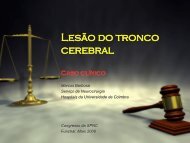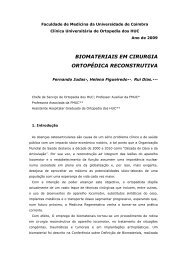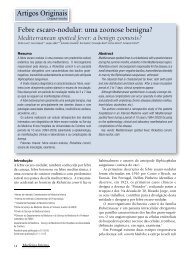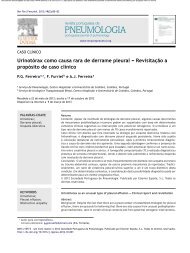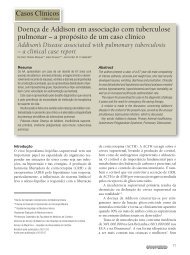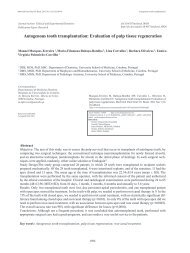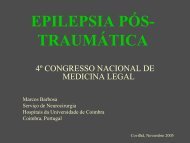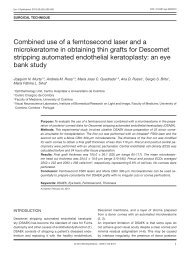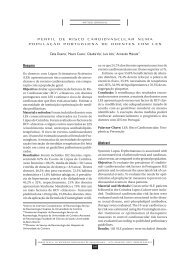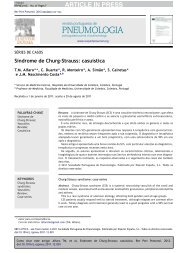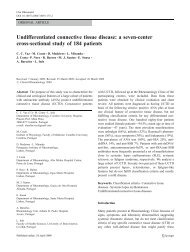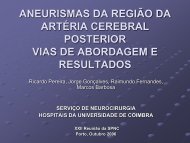Doxorubicin versus doxorubicin and cisplatin in endometrial ...
Doxorubicin versus doxorubicin and cisplatin in endometrial ...
Doxorubicin versus doxorubicin and cisplatin in endometrial ...
You also want an ePaper? Increase the reach of your titles
YUMPU automatically turns print PDFs into web optimized ePapers that Google loves.
445<br />
Table 2. Haematological toxicity grade 3 <strong>and</strong> 4 a<br />
Toxicity Treatment<br />
DOX–CDDP, n (%) DOX, n (%)<br />
WBC<br />
Grade 3 37 (44.6) 14 (17.1)<br />
Grade 4 9 (10.8) 11 (13.4)<br />
Platelets<br />
Grade 3 9 (10.8) 4 (4.9)<br />
Grade 4 2 (2.4) 0 (0.0)<br />
a 165 evaluable patients.<br />
DOX–CDDP, <strong>doxorubic<strong>in</strong></strong> <strong>and</strong> <strong>cisplat<strong>in</strong></strong>; DOX, <strong>doxorubic<strong>in</strong></strong>;<br />
WBC, white blood cells.<br />
either arm, <strong>and</strong> there were no major differences <strong>in</strong> the response<br />
rate of the various tumour sites between the treatment arms.<br />
After a median follow-up of 86 months, 82 patients (91%)<br />
treated with DOX–CDDP had died compared with 78 patients<br />
(90%) treated with DOX. Of the patients <strong>in</strong> the comb<strong>in</strong>ation arm,<br />
73 had died because of malignant disease, one of toxicity, four of<br />
cardiovascular disease, one of another chronic disease <strong>and</strong> three<br />
for unknown reasons. In the s<strong>in</strong>gle-agent treatment arm, 73 had<br />
died because of malignant disease, three of cardiovascular disease<br />
<strong>and</strong> two for other reasons.<br />
The Kaplan–Meier curves, that illustrate overall survival (OS),<br />
TTP <strong>and</strong> duration of response, are shown <strong>in</strong> Figures 1, 2 <strong>and</strong> 3.<br />
Median OS was 9 months (95% CI 7–14) <strong>in</strong> the DOX–CDDP arm<br />
<strong>versus</strong> 7 months (95% CI 4–9) <strong>in</strong> the DOX arm. The Kaplan–<br />
Maier curve reveals no significant difference <strong>in</strong> survival<br />
between the two treatment arms (log-rank, P = 0.107; Wilcoxon,<br />
P = 0.064). Overall median TTP for all treated patients was<br />
8 months (95% CI 7–11) <strong>in</strong> the DOX–CDDP arm <strong>and</strong> 7 months<br />
(95% CI 6–10) <strong>in</strong> the DOX arm. The estimated median PFS was<br />
8 months (95% CI 7–11) <strong>in</strong> the DOX–CDDP arm <strong>and</strong> 7 months<br />
(95% CI 6–10) <strong>in</strong> the DOX arm. Median duration of response was<br />
9 months <strong>in</strong> the DOX–CDDP arm <strong>versus</strong> 24 months <strong>in</strong> the DOX<br />
arm (P = 0.008). Forty-three of 54 responders (34 of 39 <strong>in</strong> the<br />
DOX–CDDP arm <strong>and</strong> 9 of 15 <strong>in</strong> the DOX arm) had progressed at<br />
the cut-off date.<br />
A Cox regression analysis was performed to identify prognostic<br />
factors for survival. After tak<strong>in</strong>g account of age, WHO<br />
performance status, FIGO stage, extent of disease <strong>and</strong> degree of<br />
differentiation, only WHO performance status appeared to be<br />
statistically significant. Stratify<strong>in</strong>g only for this variable, the<br />
treatment effect <strong>in</strong>creased, reach<strong>in</strong>g a significant difference <strong>in</strong><br />
favour of the comb<strong>in</strong>ation arm (P = 0.024, hazard ratio = 1.46,<br />
95% CI 1.05–2.03).<br />
Discussion<br />
Treatment of advanced or recurrent <strong>endometrial</strong> cancer with<br />
prostagens yields an overall response rate of 30%, with a higher<br />
response <strong>in</strong> patients with well differentiated tumours <strong>and</strong> <strong>in</strong> those<br />
with long time <strong>in</strong>tervals before relapse [3]. However, as hormone<br />
receptors predict well for response to hormonal treatment, it is<br />
imperative to f<strong>in</strong>d effective cytotoxic agents for the <strong>in</strong>itial<br />
management of those patients who are receptor negative.<br />
Table 3. Non-haematological toxicity dur<strong>in</strong>g treatment a<br />
Toxic effect<br />
WHO grad<strong>in</strong>g<br />
1 2 3 4<br />
DOX–CDDP DOX DOX–CDDP DOX DOX–CDDP DOX DOX–CDDP DOX<br />
Alopecia 1 5 14 15 59 50 1 3<br />
Nausea/vomit<strong>in</strong>g 9 28 34 29 29 10 1 0<br />
Infection 7 4 6 1 0 1 2 0<br />
Oral 18 16 7 7 5 0 0 0<br />
Cardiac 5 1 1 0 1 1 0 0<br />
Consciousness 4 0 0 1 0 1 0 0<br />
Diarrhoea 15 3 7 4 0 0 0 0<br />
Peripheral neuropathy 18 2 3 1 0 0 0 0<br />
Drug fever 3 3 4 0 0 0 0 0<br />
Pulmonary 4 0 0 1 0 0 0 0<br />
Cutaneous 2 2 1 0 0 0 0 0<br />
Local 6 1 0 0 0 0 0 0<br />
Allergy 1 2 0 0 0 0 0 0<br />
Other 14 7 6 3 1 1 0 0<br />
a 165 evaluable patients.<br />
DOX–CDDP, <strong>doxorubic<strong>in</strong></strong> <strong>and</strong> <strong>cisplat<strong>in</strong></strong>; DOX, <strong>doxorubic<strong>in</strong></strong>; WHO, World Health Organization.




